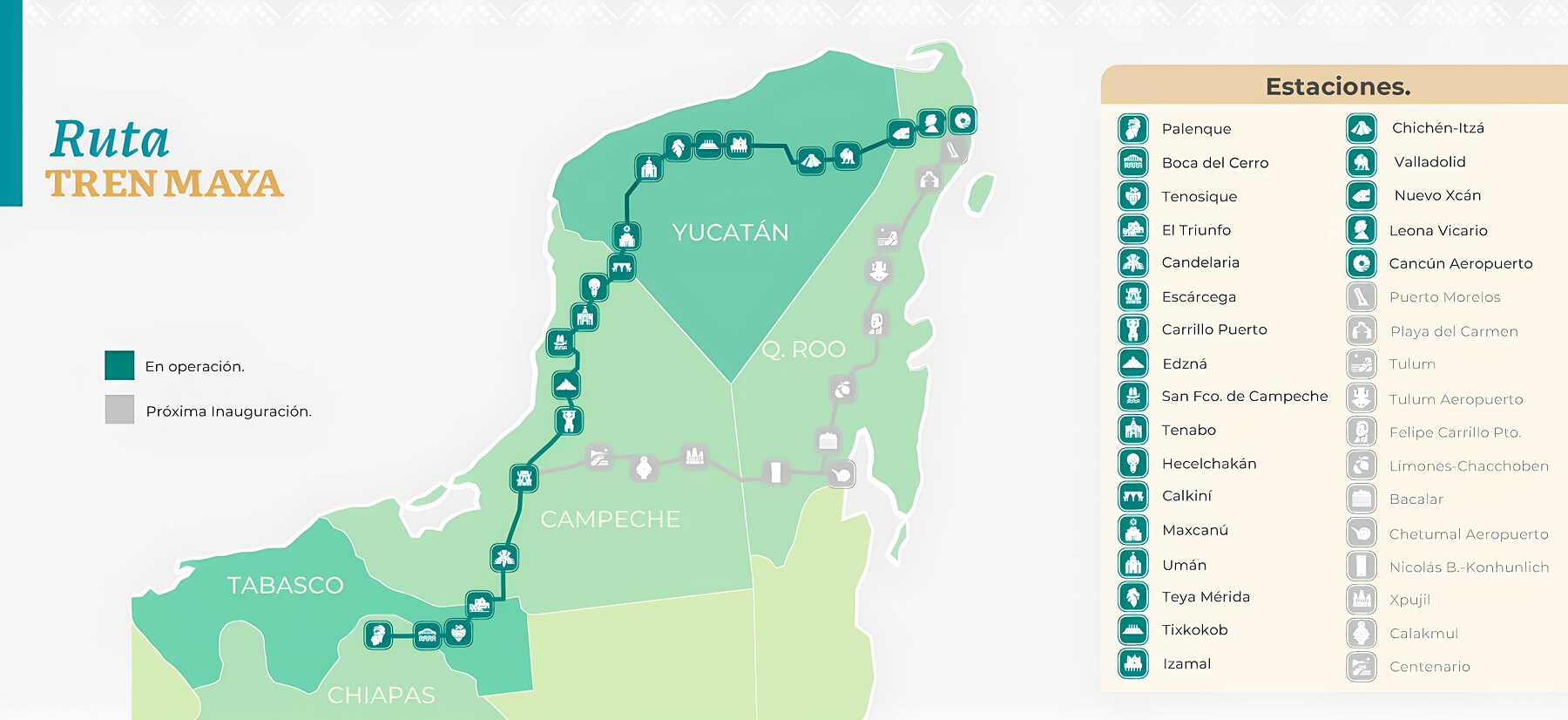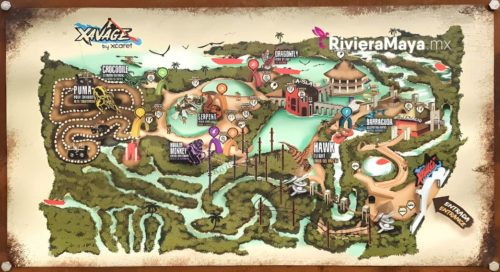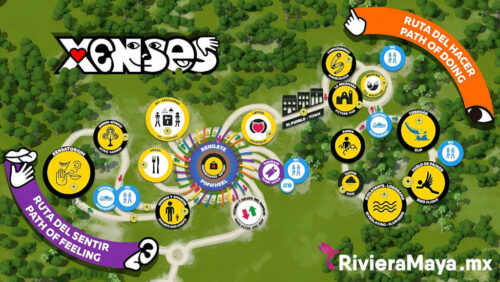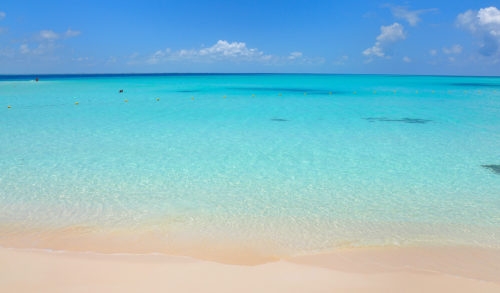The Tren Maya is an ambitious tourism and infrastructure project in Mexico, which seeks to connect the main cultural and natural attractions of the Mayan region, from Chiapas to Yucatan.
This train, which will cover more than 1,500 kilometers, is much more than a simple means of transportation. It is a unique opportunity to discover the rich Mayan history and culture, as well as to admire the natural beauty of the Mayan jungle, white sand beaches and crystalline cenotes.
Along the way, you will be able to visit archaeological sites such as Palenque, Calakmul, Uxmal and Chichen Itza, as well as enjoy outdoor activities such as snorkeling, diving and bird watching. In addition, the train will have ecological and sustainable stations, which will respect the natural environment and offer quality services to visitors.
Download PDF map 596KB. 707 Downloads.
Official site: trenmaya.gob.mx
Sections of the Tren Maya.
Section 1: Palenque – Escárcega
Section 1 of the Mayan Train connects the cities of Palenque, Boca del Cerro, Tenosique, El Triunfo, Candelaria and Escárcega, covering a distance of approximately 226 kilometers through the Lacandon jungle and the Calakmul Biosphere Reserve. This section is especially interesting for its rich biodiversity and the great archaeological value of the Mayan areas it passes through.
Stations:
- Palenque: This city is known worldwide for its impressive archaeological site, declared a UNESCO World Heritage Site. Travelers can explore the Mayan ruins and enjoy the surrounding natural beauty, such as the Misol-Ha and Agua Azul waterfalls.
- Boca del Cerro: This small community is the starting point to visit the Montes Azules Biosphere Reserve, where a great variety of endemic flora and fauna can be observed.
- Tenosique: Located on the border with Guatemala, this city has a rich history and culture, with archaeological sites such as Moral-Reforma and Pomoná. It also offers outdoor activities such as bird watching and rafting on the Usumacinta River.
- El Triunfo: This small community is known for its proximity to Calakmul National Park, one of the largest natural reserves in Mexico and home to a great variety of endangered species.
- Candelaria: Located in the heart of the Lacandon jungle, this city offers a wealth of outdoor activities such as bird watching, cave exploration and visits to indigenous communities.
- Escarcega: This city is an important transportation and trade center in the state of Campeche. Travelers can visit the archaeological site of Edzná, located only 60 kilometers away.
Opening date: December 31, 2023.
Section 2: Escárcega – Calkini
Section 2 of the Tren Maya connects Escárcega with Campeche, passing through Carrillo Puerto, Edzná, Hecelchakán and Calkini. This section offers a variety of tourist attractions, from archaeological sites to colonial towns.
Stations:
- Escarcega. This city is known as the “Forest Capital of Mexico” and is the starting point of section 2 of the Mayan Train. Visitors can enjoy the Calakmul Biosphere Reserve and Los Petenes National Park.
- Carrillo Puerto-Champoton. Within the municipality of Champotón. This station offers opportunities for hiking and other activities.
- Edzná. This ancient Maya city is known for its impressive pyramids and palaces. Visitors can explore the Temple of the Five Floors and the Temple of the Stela, among others.
- San Francisco de Campeche. This colonial walled city is a mandatory stop on the Tren Maya. Points of interest include the Fortaleza de San Miguel, the Malecon de Campeche and the Centro Historico.
- Tenabo. This small town is known for its delicious food and rich culture. Visitors can visit the Templo de San Francisco de Asis and the Municipal Market.
- Hecelchakan. This town has beautiful colonial architecture and a rich history. Points of interest include the San José Church and the Main Park.
- Calkini. This town is known for its handicrafts and delicious food. Visitors can visit the Church of San Luis Obispo and the Municipal Market.
Opening date: December 15, 2023.
Section 3: Calkini – Izamal
Section 3 of the Tren Maya is 159 kilometers long and runs through the states of Campeche and Yucatán, connecting the towns of Calkini, Maxcanú, Umán, Teya (Mérida), Tixkokob and Izamal. This stretch offers a unique opportunity to explore the rich Mayan culture, colonial history and natural beauty of the Yucatan Peninsula.
Stations
- Calkini: A charming colonial town, where you can visit the Church of San Luis Obispo, built in the 16th century, and the Municipal Market, where you can find local products and handicrafts.
- Maxcanú: Known for its production of habanero peppers and honey, it offers a unique gastronomic experience. Don’t miss the opportunity to visit Hacienda Yaxcopoil, a well-preserved example of Yucatecan hacienda architecture.
- Umán: A city in constant growth, with a mix of colonial and modern architecture. The Church of San Francisco and the Main Park are tourist attractions. In addition, Umán is known for its hammock workshops, where you can see and buy handmade hammocks.
- Teya Mérida: A small town on the outskirts of Mérida, the capital of Yucatán. Hacienda Teya is a popular place to visit, with its beautiful garden and excellent Yucatecan food. It is the gateway to Mérida, a vibrant city full of history and culture. Tourist attractions include the San Ildefonso Cathedral, the Government Palace, Paseo de Montejo and the Lucas de Galvez Market.
- Tixkokob: Famous for its production of fishing nets and guayaberas, a traditional Yucatecan shirt. The Church of San Antonio de Padua and the Municipal Market are places of tourist interest.
- Izamal: Known as the “Yellow City” for its buildings painted in this color, Izamal is a colonial city full of charm. Don’t miss the opportunity to visit the Convent of San Antonio de Padua, built in the 16th century, and climb to the top of Kinich Kakmó, an ancient Maya temple.
Section 3 of the Tren Maya offers a unique experience for those who wish to explore the rich culture and history of the Yucatan Peninsula. From colonial architecture to local food and traditions, this section is a must-see for anyone traveling to the region.
Opening date: December 15, 2023.
Section 4: Izamal – Cancun
Section 4 of the Mayan Train connects the cities of Izamal, Chichen Itza, Valladolid, Nuevo Xcan, Leona Vicario and finally Cancun. This section offers a great variety of tourist attractions, from archaeological ruins to colonial cities and paradisiacal beaches, with a length of approximately 239 kilometers.
Stations:
- Izamal: Known as the “City of the Yellow Hills”, Izamal is a charming colonial city, where beautiful Mayan convents and temples can be seen. Tourist attractions include the Convent of San Antonio de Padua, the Temple of Kinich Kakmó and the Central Park.
- Chichen Itza: One of the seven wonders of the modern world and a UNESCO World Heritage Site, Chichen Itza is one of Mexico’s most impressive archaeological sites. Tourist attractions include the Pyramid of Kukulcan, the Temple of the Warriors and the Ball Game.
- Valladolid: A colonial city founded in 1543, Valladolid is known for its beautiful cobblestone streets, lovely churches and crystal clear cenotes. Tourist attractions include the Convent of San Bernardino de Siena, Cenote Zaci and Francisco Canton Rosado Park.
- Nuevo Xcan: Located in the heart of the Mayan jungle, Nuevo Xcan is an indigenous community that offers a unique cultural experience. Tourist attractions include the Calakmul Biosphere Reserve and the archaeological site of Xcan.
- Leona Vicario: A small town that offers a wealth of outdoor adventures, such as hiking, biking and bird watching. Tourist attractions include Rio Lagartos River and Ria Celestun Natural Park.
- Cancun: Cancun’s international airport is the second largest in Mexico and the most important in the Yucatan Peninsula. From here, tourists can connect with flights to other parts of Mexico and the world.
Section 4 of the Tren Maya offers a unique experience that combines history, culture and nature, and is an excellent option for those who wish to explore the Yucatan Peninsula in its entirety.
Opening date: December 15, 2023.
Section 5: Cancun – Tulum
Section 5 of the Mayan Train connects some of the Riviera Maya’s most popular tourist destinations, including Cancun International Airport, Puerto Morelos, Playa del Carmen and Tulum. This stretch offers a variety of tourist options, from white sand beaches and crystal clear waters to Mayan archaeological sites and ecological parks.
Stations:
- Cancun. This station will connect the airport with the rest of the Riviera Maya, facilitating the access of tourists to the different destinations in the region.
- Puerto Morelos. This station will be located in the heart of Puerto Morelos, a fishing village known for its pristine beaches and marine life. Tourist attractions include the Arrecifes de Puerto Morelos National Park, the Dr. Alfredo Barrera Marín Botanical Garden and the Tilted Lighthouse.
- Playa del Carmen. This station will be located in downtown Playa del Carmen, a tourist town popular for its beaches, nightlife and marine life. Tourist attractions include Quinta Avenida, Mamitas Beach, Xcaret Park and Xel-Ha Park.
- Tulum. This station will be located near the archaeological site of Tulum, one of the best preserved Mayan cities facing the sea. Tourist attractions include the Tulum ruins, white sand beaches, Akumal and Tulum National Park.
Section 6: Tulum – Bacalar
Section 6 of the Tren Maya will connect the beautiful beaches of Tulum with the picturesque town of Bacalar, passing through Tulum Airport and the city of Felipe Carrillo Puerto. This section will offer passengers the opportunity to explore the Mayan culture, breathtaking natural beauty and world-class beaches.
Stations:
- Tulum: This station is located near the famous Mayan ruins and the beautiful beaches of Tulum. Tourists can enjoy snorkeling, diving and relaxing on the white sandy beaches.
- Tulum aeropuerto: This station will be located at the new Tulum International Airport. The airport is already an important gateway to the Mexican Caribbean.
- Felipe Carrillo Puerto: This station is located in the city of Felipe Carrillo Puerto, the capital of the municipality of the same name. Tourists can visit Coba, Cenote Azul and the Payo Obispo Bird Sanctuary.
- Limones-Chacchoben: This station is located near the archaeological site of Chacchoben, one of the most impressive Mayan sites in the region. Tourists can also visit Cenote Milagros and Cenote Bonita.
- Bacalar: This station is located in the town of Bacalar, known for its beautiful seven-color lake. Tourists can sail on the lake, visit the Fort of San Felipe and the Canal de los Piratas.
Section 6 of the Tren Maya will offer a unique experience to tourists, combining Mayan culture, natural beauty and world-class beaches.
Section 7: Bacalar – Escárcega
This section of the Tren Maya connects some of the most impressive archaeological sites and natural landscapes of the southern region of Quintana Roo and Campeche. The route includes the stations of Bacalar, Chetumal Airport, Nicolás Bravo-Kohunlich, Xpujil, Calakmul, Centenario and Escárcega.
- Bacalar: This station is located in the town of Bacalar, known for its beautiful seven-color lake and rich colonial history. Visitors can enjoy water activities, visit the Fort of San Felipe or explore the nearby Mayan ruins.
- Chetumal aeropuerto: Chetumal Airport Station is located in the capital of the state of Quintana Roo, near the international airport. Tourist attractions include the Museum of Mayan Culture, the Park of the Americas and the Malecon of Chetumal.
- Nicolás Bravo-Kohunlich: This station is located in the community of Nicolás Bravo, near the archaeological site of Kohunlich. The Mayan site features impressive structures and well-preserved murals, surrounded by tropical jungle.
- Xpujil: Xpujil Station is located in the town of the same name, near several Mayan archaeological sites, including Calakmul, Becán and Chicanná. Visitors can explore the ruins and enjoy the natural beauty of the rainforest.
- Calakmul: This station is located in the heart of the Calakmul Biosphere Reserve, near the archaeological site of the same name. Calakmul is one of the largest and best preserved Mayan sites, surrounded by tropical rainforest and a great diversity of wildlife.
- Centenario: Centenario station is located in the city of Campeche, near the historic center and port. Tourist attractions include the Fortaleza de San Miguel, the Templo de San Francisco and the Malecon of Campeche.
- Escarcega: The final station of this stretch is located in the city of Escarcega, in the state of Campeche. Visitors can enjoy local food, visit the City Museum or explore the nearby Mayan ruins of Edzná.
Map of the archaeological sites accessible from the Tren Maya.
Download PDF map 735KB. 200 Downloads.
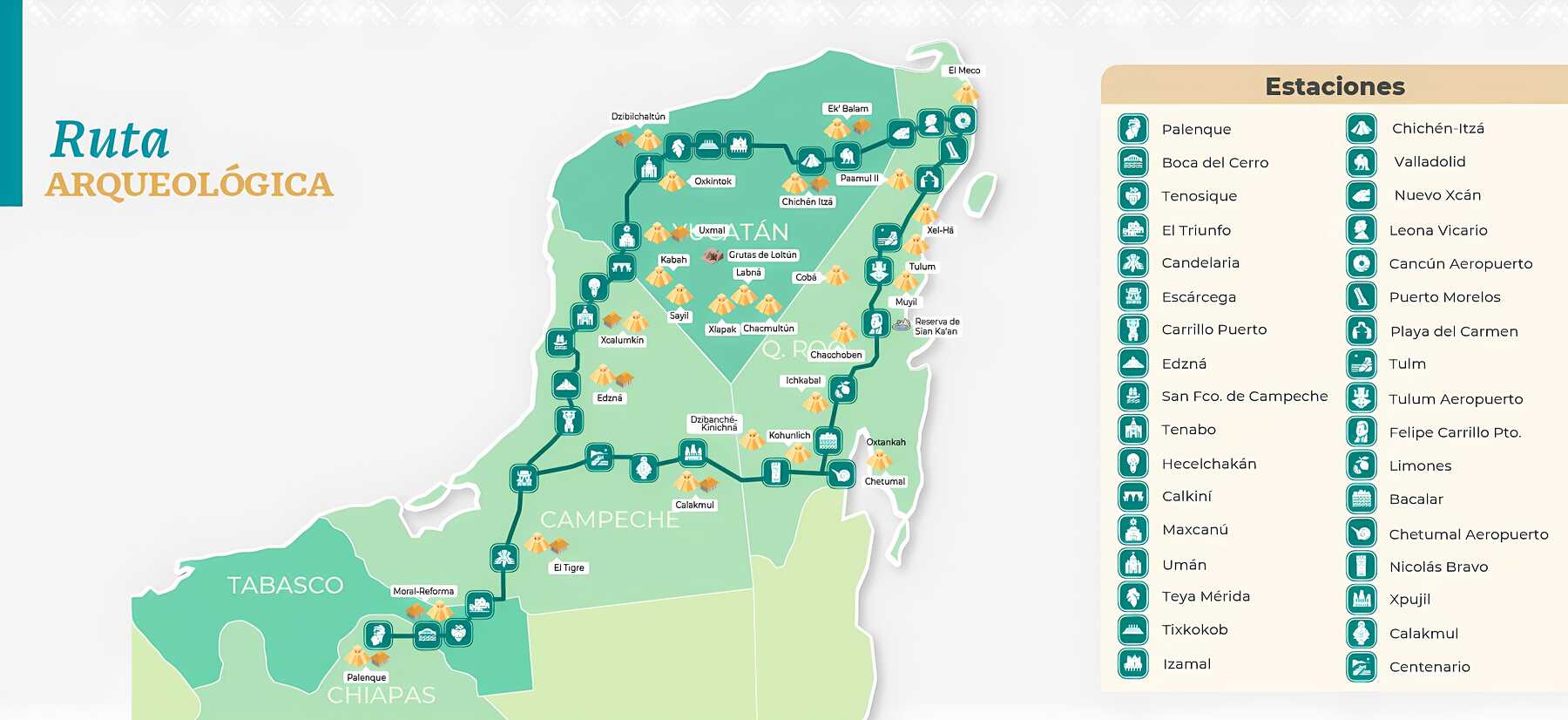
Archaeological sites along the route of the Mayan Train
The Mayan Train route offers an unprecedented opportunity to explore the most fascinating archaeological sites of the Mayan civilization, which once flourished in the Yucatan Peninsula and much of the states of Chiapas, Tabasco, Campeche and Quintana Roo in Mexico.
Here is a list of some of the most popular and exciting archaeological sites to visit along the Tren Maya route:
- Palenque
- Tenosique
- Balancán
- Candelaria
- Calakmul
- Escárcega
- Champotón
- Campeche
- Edzná
- Uxmal
- Kabah
- Labná
- Oxkintok
- Chichen Itza
- Ek Balam
- Izamal
- Mayapán
- Dzibilchaltún
- Tulum
- Coba
- Muyil
- Kohunlich
Each of these archaeological sites offers a unique and fascinating experience, and the Tren Maya will facilitate access to them, allowing visitors to immerse themselves in the rich Maya history and culture like never before.
Great guide to the Tren Maya (PDF)
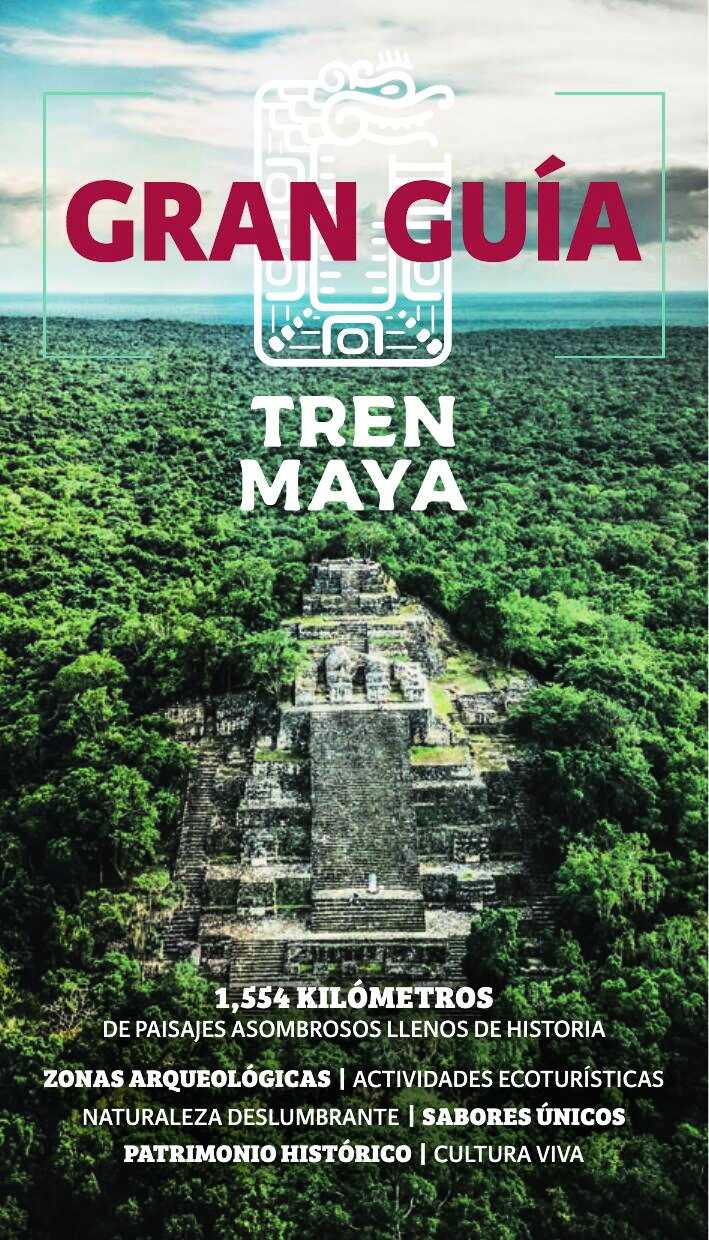
Through this guide, you will discover the treasures that this region holds, from archaeological sites and historic cities to magical towns, nature reserves and ecological parks. In addition, it will bring you closer to the traditions and customs that today are the hallmark and emblem of the heritage of a multicultural nation.
The guide is divided by stations, beginning in Chiapas and continuing through Tabasco, Campeche, Yucatan and Quintana Roo. You will find descriptions, infographics, maps, routes, photographs and texts that will open the door to a new experience and allow you to live the Mexican Southeast in a different way.
Don’t miss the opportunity to get on the Mayan Train and discover one of the most extraordinary cultures that have ever existed in the world, enjoy your trip!
Great guide of the Mayan Train in Spanish (PDF)